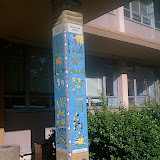- Michelle Malkin » Sickblogging
- The Jawa Report: Sick Blogging
- Last Chance Cafe: Sick Blogging
- Wilsonizer: Sick Blogging, Live from Home!
- Tuesday sick-blogging: Rock 'n Roll Reading
And what have I to say today? Not much but here is a preview of things to come. I have a feeling that Obama is stalking me scientifically. Why? Well, I am one or two steps removed from a huge number of his appointees and I plan to write about them in the next few weeks once I get better. One things the science bloggers might not have heard about is the passion Adm. Dennis Blair has for science. Dennis Blair is Obama's pick for DNI (Director of National Intelligence) and I know him through a program called the Defense Science Studies Group (DSSG). I will write more about this later, but what I can say here is I think Blair is a brilliant pick by Obama. Not only does he have a strong military and intelligence background, but more importantly to me, he believes in evidence, and is a strong supporter of science. And below is a little pic of me getting my certificate from Adm. Blair.




